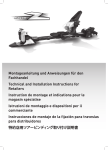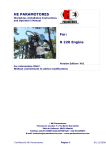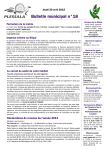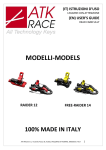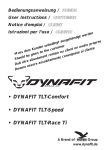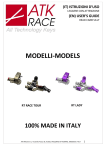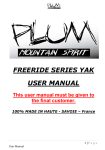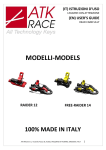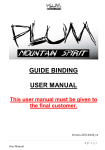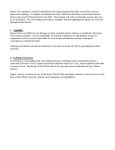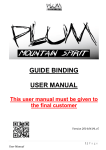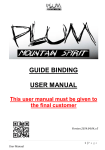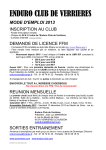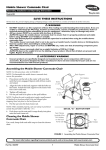Download BEDIENUNGSANWEISUNG – KUNDE für TOURENBINDUNG
Transcript
BEDIENUNGSANWEISUNG – KUNDE für TOURENBINDUNG User Manual – Client for Touring Binding MODE D’EMPLOI – CLIENT pour FIXATION DE RANDONNEE ISTRUZIONI PER L’USO – CLIENTE per ATTACCHI DA SCIALPINISMO INSTRUCCIONES DE USO - para el cliente – para FIJACIONES DE TRAVESÍA 使用説明書- スキー板ビンディング User Manual – Client for Touring Binding hagan Z Thank you for choosing the hagan Z. For your interest and due to safety reasons we ask you to read the following references considerately and to act accordingly. ENGLISH HAZARD NOTE • • hagan Z bindings may exclusively be used with alpine ski boots according to ISO 5355 and touring ski boots according to ISO 9523! • hagan ski bindings comply with applicable national and international standards (ISO, DIN) and were tested according to these guidelines by independent testing institutes (TÜV-Süd Product Service Munich). • An adjusting range of more than Z 10 is not standardized. The setting in this range is at one’s peril. • Nevertheless a safety binding cannot release absolutely without fail under any circumstance and is not supposed to prevent knee injury. • As a skier you should be aware of the dangers of this sport. Always adopt your skiing and your intended routes to your individual skill level and your skiing ability. • Comply with the warnings and guidelines in the ski areas. • Choose your touring routes carefully, do not overestimate your capability and never tour alone. • Always use avalanche safety equipment if you are touring (avalanche transceiver, probe, shovel) • Always consider the weather and avalanche forecast strictly. • Freeride skiers are supposed to use protective gear like helmet and protectors. • We recommend to use ski leashes or a powder band if skiing in deep powder. • Since an incorrect mounting or setting of the binding could result in serious injuries, we strongly recommend to let both be done by qualified ski retailers. • To ensure the intended safety functions of the binding, we recommend not to modify the settings implemented by the qualified ski retailer. • Due to staining, longer or incorrect storage or non-usage, the release setting of your binding can change. We strongly recommend to let your bindings be re-adjusted with a convenient measurement device by a qualified ski retailer, before every season. • Non-standard ski boots or heavily worn ski boot soles can negatively affect the release of your binding. Make sure a qualified ski retailer is checking the proper function of your equipment on a regular basis. • Since ski bindings which are carried on a roof rack are exposed to salt, dirt • • • • and other contamination, which can negatively affect the proper function, we strongly recommend the use of a binding cover, a ski bag or a ski box. Every improper use of the binding for example on a mono ski, changes to binding components and the ski stopper increase the risk of non-releases or unintended releases. The attachment of non-brand accessories and/or components can negatively affect the proper function of the binding and the stopper and should therefore only be taken out by a qualified ski retailer. Never ski under the influence of alcohol and drugs. Please store the receipt, adjusting verification and the user manual. If you have purchased this binding via the internet it has be to adjusted and checked by an authorized hagan retailer according to your personal data and skiing abilities. Hagan does not assume liability for any kind of self adjustment or mounting and its results. OPERATION AND SETTINGS Since the settings of the binding not only depend on the binding model, but mainly on the ski boot and the skier type, they should be carried out exclusively by qualified ski retailers and double checked with suited measuring devices. You can read off the adjusted Z-settings of the retailer on the release value indicator at the toe piece (4) and the heel piece (5). Z-settings above Z 10 are not according to the norm and are at one’s own risk! ill. (A/B) Adjustment of the sole height The position of the toe sole holder (2) can be adjusted with the sole height adjusting screw (18) to the specific sole height. By turning the screw the sole holder is moving up or down. You can test the proper adjustment with a paper stripe (17) fitted between sole and glide AFT (18). It should be possible to be pulled out without being ruptured ill. (C), while the boot is pulled upward. To check: the gap between sole and glide AFT (14) should have a maximum height of 0,5 mm. Attention: the toe sole holders may only be adjusted by hand! If the sole does not fit into the toe sole holders (2) it is not according to the norm. The rubber sole has to be sanded down as far as the above mentioned paper stripe test can be carried out Adjustment of the sole length The whole heel part has to be screwed against the boot sole using the length adjustment screw (10) until the head of the adjustment screw is flush with the heel unit ill. (D/E). Step in (also step in after a release) Clean your sole from snow, ice and dirt. If the heel part (7) is locked, open it by pushing on the opening lever (8). Place the toe of your boot between the wings (2) of the toe piece (1) and lock the heel piece by pushing down the heel of your boot. Step out (also after a crash and in a plight) Use your ski pole to push down the opening lever (8) via the hutch (9) and raise your heel out of the binding at the same time ill. (F) Advice: There is a risk of injury if fingers or the whole hand get stuck between opening lever (8) and heel parts. Make sure you always open the binding by pushing down the opening lever with a pole, a boot or with the ball of your hand ill. (G) Switching from downhill into touring mode To shift from “downhill” into “touring” mode the locking device (11) has to be switched into the position downhill or touring using the lever of the climbing aid (12). Therefore the tip of the ski pole has to be placed into the intended notch and then the ski pole has to be pushed forward ill. (I) Switching from touring into downhill mode In order to ski downhill with the binding the climbing aid lever (12) has to be pushed flat backward with the help of a pole, a boot or the ball of your hand until it rests on the ski. Advice: Before switching from touring into downhill mode the binding has to be cleaned from snow, ice and dirt! The locking mechanism has to lock easily! Using the climbing aid In touring mode the climbing aid can be adjusted into three different positions – angle of the biding frame either 10° or 15° ill. (J/K) The third position (5°) ill. (L) results from the climbing aid lever being positioned flat on the ski (locking device engaged) and the binding frame (13) is positioned on the locking device (11) ill. (G). Pull the climbing aid forward into the two higher positions ill. (M) or push it backward for the lower positions ill. (N). Caution: Never start skiing downhill with the binding being unlocked! If the Z-setting of the binding is between DIN/ISO 8-10 the required opening and locking forces tend to be higher. Get used to this circumstances before starting a tour or skiing out of boundaries and use only settings which you are able to handle even in a tight spot! 06/10 © Hagan Ski GesmbH, Andiesen 11, 4774 St.Marienkirchen, Austria / Art. Nr. TU055-K How to carry the skis Place one ski on the ground, then slide the other one along the base from top to bottom until the ski brakes (16) latch. Accessories The following accessories are available at your ski retailer: Crampons for skis with a waist width of: max. 85mm, max. 100mm, max. 115mm max. 100mm, max. 115mm Ski leashes Using the crampons Pivot the crampon (30) onto the binding frame from the bottom up and slide it forward until the cut-outs within the crampon adapter (31) connect with the crampon mounting points (19) of the binding frame (13). Now push the crampon locking lever (33) upward until it locks. Dismount in the reverse order ill. (P,Q,R,S) Caution: Use the crampon only on crud snow or ice and only with a climbing aid setting in stage 1 or 2! In stage 3 the crampon teeth are too short and in stage 0 (flat on the ski), they are too long. If you decide to use the crampons in stage 0 on soft spring snow, there is the chance of snow build up between crampon and the surface of the ski. This may lead to a strong charge of the binding parts. Please try to avoid and wax both the ski surface and the inside of the crampon, if necessary. Ski leashes Also ski leashes can be used instead of ski stoppers. The ill. (T,U,V,W) indicate the mounting of the leash to the heel piece (7). The lug (28) has to be threaded through the slit according to ill. (V), whereas the loose end of the lug (28) has to point backwards. Caution: Check whether the leash is securely engaged! If attaching the ring band to the ski boot, make sure that the hook (27) is securely linked with the ring (26). The leash avoids loosing the ski in case of a binding release, but definitely increases the danger of injuries. Worn or damaged leashes have to be replaced. 1 2 3 4 5 6 7 8 9 10 DESCRIPTION OF THE BINDING PARTS 12 13 14 15 16 17 18 19 20 21 22 23 24 Toe piece Toe sole holder Adjusting screw lateral release Adjusting scale lateral release Adjusting scale front release Adjusting screw front release Heel cup Opening lever Pole hutch of the opening lever Adjusting screw for forward pressure and sole length Lock for downhill mode and climbing aid stage 1 Climbing aid lever Main Frame Gliding AFD Ski brake pedal Ski brake lever Paper test stripe Adjusting screw sole height (front) Crampon mounting points Pivot shaft Binding screws Rear standing platform Rear side of the main frame Base plate 25 26 27 28 29 Ski leashes Ring Hook Lug Slit 11 30 Crampon 31 Crampon adapter 32 Crampon lock Care and maintenance The warranted guarantee by hagan presumes that the owners manual as well as the warning notices have been followed and taken care of. Make sure to get the binding checked according to its function and correct adjustment regularly or at least before starting a new ski season. Always store your skis with the binding locked in a dry and cool, but frost-protected place. Caution: Only use hagan approved lubricants. Otherwise friction values could alter, leading to unintended releases. Warranty The hagan warranty has to be conducted by an authorized ski retailer. A case of warranty takes place if the product or a part of it does not function properly according to defects in material or production. The final decision about an objected defect in production can only be taken by a person which is assigned by hagan. hagan decides whether a defective binding is going to be replaced or repaired within a time range of two years ex purchase date (rental- and demo bindings: one year). Warranty disclaimer Exempted from warranty are damages caused by improper use, non professional mounting, disregard of the owners manual, incorrect adjustment, insufficient maintenance and care, skiing accidents, wrong use of the product or normal wear. All wear parts like mounting plates, levers and prints are exempted from the warranty. Furthermore hagan is not liable for causal or consequential damages of any kind, unless such a limitation of liability is distinctly prohibited by the legislator. Any kind of warranty claim deduced from this circumstance is distinctly rejected, unless such an rejection is prohibited by the law. In this case the awarded warranty claim is only given in the above mentioned term of guarantee. According to DIN/ISO 13992 (Tour) and DIN/ISO 9462. Tested and approved by the TÜV-Süd Product Service GmbH, München Made in Germany All operating and mounting instructions are available as a PDF data base at www.hagan-ski.com Hagan Ski Ges.m.b.H., Andiesen 11, 4774 St.Marienkirchen, Austria, +43 7711 33133-0 Mail: [email protected] Artikel No. TU055K / issue 06.2010 06/10 © Hagan Ski GesmbH, Andiesen 11, 4774 St.Marienkirchen, Austria / Art. Nr. TU055-K ENGLISH Ski stoppers for skis with a waist width of: max. 85mm, max. 90mm, hagan Z 9 8 6 7 18 2 1 22 15 14 5 12 10 19 21 16 3 11 23 24 13 20 14 18 4 5 2 Abb. A 10 Abb. C Abb. B NO 17 OK 8 7 Abb. D 14 9 Abb. E Abb. F Abb. H Abb. I 12 NO Abb. G 06/10 © Hagan Ski GesmbH, Andiesen 11, 4774 St.Marienkirchen, Austria / Art. Nr. TU055-K 10° 15° 5° 13 12 12 12 Abb. J Abb. K Abb. L 12 12 12 Abb. M Abb. N Abb. O 13 19 30 31 Abb. P Abb. Q Abb. R 28 33 7 27 29 26 25 Abb. S Abb. T Abb. U 25 Abb. V Abb. W 06/10 © Hagan Ski GesmbH, Andiesen 11, 4774 St.Marienkirchen, Austria / Art. Nr. TU055-K IAS-Test






